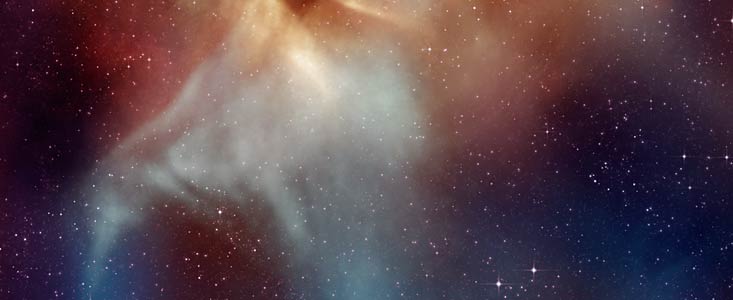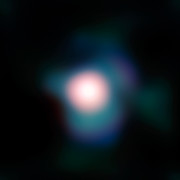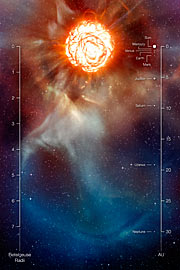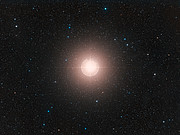Persbericht
Scherpste blik op Betelgeuze onthult hoe reuzensterren massa verliezen
Het ware gezicht van een superreus onthuld
29 juli 2009
Twee teams van sterrenkundigen hebben, met behulp van de Europese Very Large Telescope (VLT), de tot nu toe scherpste opnamen van reuzenster Betelgeuze gemaakt. Hierop is te zien dat de ster een gaspluim heeft die bijna net zo groot is als ons zonnestelsel. Ook heeft Betelgeuze een gigantische gasbel aan het oppervlak. Deze ontdekkingen leveren belangrijke aanwijzingen die helpen verklaren hoe zulke superreuzen met enorme snelheid materie uitstoten.
De rode 'superreus' Betelgeuze - de op een na helderste ster in het sterrenbeeld Orion - is een van de grootste en helderste sterren die we kennen. Hij is bijna duizend keer zo groot als de zon [1]. en straalt 100.000 keer zo veel licht uit. Deze extreme eigenschappen wijzen erop dat deze kortlevende ‘sterrenkoning’ bijna gaat sterven. Met een leeftijd van enkele miljoenen jaren nadert Betelgeuze het einde van zijn bestaan en zal dan exploderen als een enorme supernova, die zelfs bij daglicht vanaf de aarde te zien zal zijn.
Er zijn nog enkele onopgeloste mysteries rond rode superreuzen, bijvoorbeeld hoe deze kolossale monsters zulke enorme hoeveelheden materie uitstoten, ongeveer één zonsmassa in slechts 10.000 jaar. Twee teams van sterrenkundigen hebben met behulp van ESO’s Very Large Telescope (VLT) en zeer geavanceerde technieken de gigantische ster nader onderzocht. Hun gecombineerde resultaten wijzen erop dat de oplossing van dit mysterie nabij is.
Het eerste team maakte de scherpste opnamen ooit van reuzenster Betelgeuze met het adaptieve optische instrument NACO, gecombineerd met de zogenoemde ‘lucky imaging’ techniek. Met ‘lucky imaging’ worden heel veel foto’s gemaakt en vervolgens worden alleen de scherpste opnamen gecombineerd tot één beeld, dat veel scherper is dan één opname met een langere belichtingstijd zou zijn.
De zo verkregen NACO opnamen bereiken bijna de theoretische scherptelimiet van een 8-meter telescoop. De resolutie is maar liefst 37 milliboogseconden, ongeveer de grootte van een tennisbal op het International Space Station (ISS), gezien vanaf de aarde.
“Dankzij deze voortreffelijke opnamen hebben we een grote gaspluim ontdekt op het oppervlak van Betelgeuze,” zegt teamleider Pierre Kervella van Paris Observatory. De gaspluim is minstens zes keer zo lang als de diameter van de ster, wat overeenkomt met de afstand van de zon tot Neptunus.
“Dit is een duidelijke aanwijzing dat de ster zijn materie niet gelijkmatig naar alle kanten uitstoot,” voegt Kervella toe. Er zijn twee mogelijke oorzaken voor deze asymmetrie. De eerste veronderstelt dat het massaverlies optreedt boven de poolkappen van de gigantische ster, mogelijk als gevolg van zijn rotatie. De andere mogelijkheid is dat zo’n gaspluim wordt gegenereerd boven grootschalige gasbewegingen in de ster zelf, ook wel convectie genoemd, vergelijkbaar met de watercirculatie in een fluitketel op een gasfornuis.
Om tot een oplossing te komen moesten de astronomen de superreus verder onderzoeken. Hiervoor maakten Keiichi Ohnaka en zijn collega’s van het Max Planck Instituut voor Radio Astronomie in Bonn, Duitsland gebruik van interferometrie. Met het AMBER instrument op ESO’s Very Large Telescope Interferometer, dat licht van drie 1,8-meter hulptelescopen van de VLT combineert, verkregen de astronomen waarnemingen die even scherp zijn als die van een reusachtige virtuele 48-meter telescoop. Met deze resolutie konden de astronomen indirect gegevens detecteren die nog vier keer scherper waren dan de NACO opnamen - de afmeting van een knikker op het ISS, gezien vanaf de grond.
“Onze AMBER waarnemingen zijn de scherpste waarnemingen ooit gemaakt van Betelgeuze. Bovendien hebben we de gasverplaatsingen aan het oppervlak van Betelgeuze gedetecteerd, dit is behalve bij de zon nog nooit eerder gedaan,” zegt Ohnaka.
De AMBER waarnemingen onthullen dat de gasbellen in de atmosfeer van Betelgeuze hevig op en neer bewegen en dat deze gasbellen net zo groot zijn als de superreus zelf. Volgens de astronomen tonen de ongeëvenaarde waarnemingen aan dat deze grootschalige gasverplaatsingen aan de basis staan van de waargenomen uitstoot van materie.
Noten
[1]Als Betelgeuze in het centrum van ons zonnestelsel zou staan, zou de ster reiken tot de baan van Jupiter en zowel Mercurius, Venus, Aarde, Mars en de asteroïdengordel in zich opnemen.
Meer informatie
Dit onderzoek is gepresenteerd in twee papers die verschijnen in Astronomy and Astrophysics: The close circumstellar environment of Betelgeuse: Adaptive optics spectro-imaging in the near-IR with VLT/NACO, by Pierre Kervella et al., and Spatially resolving the inhomogeneous structure of the dynamical atmosphere of Betelgeuse with VLTI/AMBER, by Keiichi Ohnaka et al.
De teams bestaan uit P. Kervella, G. Perrin, S. Lacour, en X. Haubois (LESIA, Observatoire de Paris, Frankrijk), T. Verhoelst (K. U. Leuven, België), S. T. Ridgway (National Optical Astronomy Observatories, USA), en J. Cami (University of Western Ontario, Canada), en uit K. Ohnaka, K.-H. Hofmann, T. Driebe, F. Millour, D. Schertl, en G. Weigelt (Max-Planck-Institute for Radio Astronomy, Bonn, Duitsland), M. Benisty (INAF-Osservatorio Astrofisico di Arcetri, Florence, Italë), A. Chelli (LAOG, Grenoble, Frankrijk), R. Petrov en F. Vakili (Lab. H. Fizeau, OCA, Nice, Frankrijk), en Ph. Stee (Lab. H. Fizeau, OCA, Grasse, Frankrijk).
ESO, de Europese Zuidelijke Sterrenwacht, is de belangrijkste intergouvernementele sterrenkundeorganisatie in Europa en wereldwijd het meest productieve astronomische observatorium. ESO wordt ondersteund door 14 landen: België, Denemarken, Duitsland, Finland, Frankrijk, Italië, Nederland, Oostenrijk, Portugal, Spanje, Tsjechië, het Verenigd Koninkrijk, Zweden en Zwitserland. ESO voert een ambitieus programma uit gericht op het ontwerp, de bouw en de exploitatie van krachtige grondobservatoria die astronomen in staat stellen om belangrijke wetenschappelijke ontdekkingen te doen. ESO speelt ook een leidende rol in het bevorderen en organiseren van samenwerking in het sterrenkundig onderzoek. ESO exploiteert drie observatielocaties van wereldklasse in Chili: La Silla, Paranal en Chajnantor. Op Paranal exploiteert ESO de Very Large Telescope (VLT), 's werelds meest geavanceerde optische observatorium en ESO is de Europese partner van de revolutionaire telescoop ALMA. ESO is momenteel bezig met ontwerpstudies voor de 42-meter Europese Extremely Large optische/nabij-infrarood Telescoop ( E-ELT), die ‘het grootste oog op de hemel’ ter wereld zal worden.
Links
- Science paper: Kervella, P. et al. and Ohnaka, K. et al.
- More info:: VLT web pagee
- More info: Adaptive optics web page
- More info: Interferometry web page
Contact
Pierre Kervella
Observatoire de Paris-Meudon
Paris, France
Tel: +33 1 45 07 79 66
E-mail: Pierre.Kervella@obspm.fr
Keiichi Ohnaka
Max-Planck Institute for Radio Astronomy
Bonn, Germany
Tel: +33 1 45 07 79 66
E-mail: kohnaka@mpifr-bonn.mpg.de
Olivier Hainaut
ESO
Garching, Germany
Tel: +49 89 3200 6752
E-mail: ohainaut@eso.org
Marieke Baan (Perscontact Nederland)
ESO Science Outreach Network
en NOVA Informatie Centrum
Tel: +31(0)20-5257480
E-mail: eson-netherlands@eso.org
Over dit bericht
| Persberichten nr.: | eso0927nl |
| Legacy ID: | PR 27/09 |
| Naam: | Betelgeuse |
| Type: | Milky Way : Star : Evolutionary Stage : Red Supergiant |
| Facility: | Very Large Telescope |
| Instruments: | AMBER, NACO, VINCI |
| Science data: | 2009A&A...504..115K 2009A&A...503..183O |
Our use of Cookies
We use cookies that are essential for accessing our websites and using our services. We also use cookies to analyse, measure and improve our websites’ performance, to enable content sharing via social media and to display media content hosted on third-party platforms.
ESO Cookies Policy
The European Organisation for Astronomical Research in the Southern Hemisphere (ESO) is the pre-eminent intergovernmental science and technology organisation in astronomy. It carries out an ambitious programme focused on the design, construction and operation of powerful ground-based observing facilities for astronomy.
This Cookies Policy is intended to provide clarity by outlining the cookies used on the ESO public websites, their functions, the options you have for controlling them, and the ways you can contact us for additional details.
What are cookies?
Cookies are small pieces of data stored on your device by websites you visit. They serve various purposes, such as remembering login credentials and preferences and enhance your browsing experience.
Categories of cookies we use
Essential cookies (always active): These cookies are strictly necessary for the proper functioning of our website. Without these cookies, the website cannot operate correctly, and certain services, such as logging in or accessing secure areas, may not be available; because they are essential for the website’s operation, they cannot be disabled.
Functional Cookies: These cookies enhance your browsing experience by enabling additional features and personalization, such as remembering your preferences and settings. While not strictly necessary for the website to function, they improve usability and convenience; these cookies are only placed if you provide your consent.
Analytics cookies: These cookies collect information about how visitors interact with our website, such as which pages are visited most often and how users navigate the site. This data helps us improve website performance, optimize content, and enhance the user experience; these cookies are only placed if you provide your consent. We use the following analytics cookies.
Matomo Cookies:
This website uses Matomo (formerly Piwik), an open source software which enables the statistical analysis of website visits. Matomo uses cookies (text files) which are saved on your computer and which allow us to analyze how you use our website. The website user information generated by the cookies will only be saved on the servers of our IT Department. We use this information to analyze www.eso.org visits and to prepare reports on website activities. These data will not be disclosed to third parties.
On behalf of ESO, Matomo will use this information for the purpose of evaluating your use of the website, compiling reports on website activity and providing other services relating to website activity and internet usage.
Matomo cookies settings:
Additional Third-party cookies on ESO websites: some of our pages display content from external providers, e.g. YouTube.
Such third-party services are outside of ESO control and may, at any time, change their terms of service, use of cookies, etc.
YouTube: Some videos on the ESO website are embedded from ESO’s official YouTube channel. We have enabled YouTube’s privacy-enhanced mode, meaning that no cookies are set unless the user actively clicks on the video to play it. Additionally, in this mode, YouTube does not store any personally identifiable cookie data for embedded video playbacks. For more details, please refer to YouTube’s embedding videos information page.
Cookies can also be classified based on the following elements.
Regarding the domain, there are:
- First-party cookies, set by the website you are currently visiting. They are stored by the same domain that you are browsing and are used to enhance your experience on that site;
- Third-party cookies, set by a domain other than the one you are currently visiting.
As for their duration, cookies can be:
- Browser-session cookies, which are deleted when the user closes the browser;
- Stored cookies, which stay on the user's device for a predetermined period of time.
How to manage cookies
Cookie settings: You can modify your cookie choices for the ESO webpages at any time by clicking on the link Cookie settings at the bottom of any page.
In your browser: If you wish to delete cookies or instruct your browser to delete or block cookies by default, please visit the help pages of your browser:
Please be aware that if you delete or decline cookies, certain functionalities of our website may be not be available and your browsing experience may be affected.
You can set most browsers to prevent any cookies being placed on your device, but you may then have to manually adjust some preferences every time you visit a site/page. And some services and functionalities may not work properly at all (e.g. profile logging-in, shop check out).
Updates to the ESO Cookies Policy
The ESO Cookies Policy may be subject to future updates, which will be made available on this page.
Additional information
For any queries related to cookies, please contact: pdprATesoDOTorg.
As ESO public webpages are managed by our Department of Communication, your questions will be dealt with the support of the said Department.






